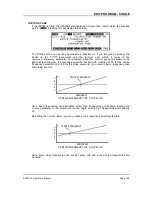
SAMPLE
Page 116
S3000XL Operator’s Manual
SAMPLE MODE
Edit sample is where you make and edit your recordings. In this mode, you may, amongst
other things, trim, loop, join, merge, reverse, re-sample and timestretch recordings. But
before we can do any of that, we first need to make some recordings.
WHAT IS SAMPLING?
Sampling is a process where we record sound digitally. All natural sound comes in the
form of variations in sound pressure. Using a microphone, we can convert those changes
in air pressure into rising and falling voltages. Once they exist in that format, we can
process them through ANALOGUE TO DIGITAL CONVERTERS (ADC) to turn those
voltages into streams of digital data. Once they exist as digital data, we can edit them with
alarming precision.
SOUND
MIC
VOLTAGE
WAVEFORM
ADC
DIGITISED
WAVEFORM
In the ADC, the sound is ‘sampled’ at a rate of 44,100 times per second. You can liken
this to film. If we take a lot of photographs in very quick succession, when we play it back,
we have the illusion of movement. The same is true of sampling. If we take enough
samples, we get an accurate reproduction of the sound. To carry this analogy even
further, if you think of the very early days of film where they didn’t take so many frames in
a second, the results were jerky and distorted. The same could be said about old
samplers - because they sampled less (that is, the sampling rate was lower), the sound
quality was not so good. In order to reproduce sound accurately, you need to sample at a
frequency that is at least twice the upper reaches of the sounds frequency range. In other
words, if a sound contains frequencies that extend to, say, 15kHz, you need to sample at
30kHz at least. Instruments such as cymbals which are very bright and contain many
overtones need to be sampled at 40kHz. A bass drum, however, which has very few
upper harmonics, could feasibly be sampled at 20kHz.
The S3000XL samples at 44.1kHz, the same as compact disc so you can be sure you are
getting CD quality sound from your sampler.
The digitised waveform is loaded into RANDOM ACCESS MEMORY (RAM) where it exists
as numbers. As you know, computers and microprocessors are very good at dealing with
numbers and so we are able to rearrange those numbers and so alter the sound.
At the end of the process, we need to be able to convert those numbers back into an
electrical analogue waveform and so the numbers are reconstituted into analogue via
DIGITAL TO ANALOGUE CONVERTERS and output to your mixer or amplifier.







































